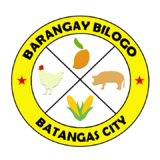Bilogo
Bilogo (officially Barangay Bilogo) is one of the 105 barangays constituting Batangas City, Philippines.[2] It is a rural community situated east of the city and is about twenty minutes drive from Poblacion.[3] Brgy. Bilogo is politically subdivided into seven puroks and has three sitios: Bagong Pook, Callejon or Ilaya, and Santolan.[1]
Barangay Bilogo | |
|---|---|
An entrance to Brgy. Bilogo | |
 Seal | |
| Country: | Philippines |
| Province: | Batangas |
| City: | Batangas City |
| Government | |
| • Barangay Captain: | Jaime I. Villena |
| • Councilors: | List
|
| • Secretary | Joy V. Perez |
| • Treasurer | Elizabeth M. Lubis |
| Area | |
| • Total | 3.5 km2 (1.4 sq mi) |
| Population (2015)[1] | |
| • Total | 2,011 |
Etymology
Based on an old legend, Bilogo came from bayugo, the Filipino/Tagalog word for the "fruit of the gugo tree" which was formerly teeming in the community. Soon, bayugo became biyugo until it was finally referred as Bilogo.[4]
History
Since 1870, Bilogo has been one of the earliest barangays of Batangas City.[5] Bilogo belonged to a wealthy Spanish official who was married to one of its native inhabitants. More inter-marriages between local and foreign residents followed and the population gradually increased. Years later, Bilogo was an elevated as a sitio and was merged with Sitio Maapaz, becoming known as Bilogo Maapaz. Eventually, Bilogo and Maapaz separated and became independent barangays.[4]
Quintin Manalo was one of the first teniente del barrios to served service of leadership for Brgy. Bilogo. Subsequent elections installed the following as his successors: Fortunato Sulit, Jose Manalo, Miguel Ebe, Exequiel Perez, Victor Castillo, Miguel Chavez, Felix Sulit, Juan Perez, and Dionisio Panganiban. During World War II, houses of Eleuterio Canent, Hilarion Lontoc, Pedro Ramos, and Francisco Rosales were burned down by Japanese soldiers because one of their officers was allegedly murdered in Brgy. Bilogo. It was in 1960 when a public elementary school was constructed through government supervisions.[4] For three consecutive years (1998-2000), Brgy. Bilogo was hailed as the "most cleanest and healthiest barangay of Batangas City" and even of the entire Calabarzon; this happened throughout the leadership of Angel Umali.[6] Alfredo Villanueva assumed as barangay captain after Umali.[7] During his term, improvements of waterworks were made possible and a materials recovery facility was constructed to sustain proper segregation of solid wastes.[8] In 2007, Villanueva was succeeded by Ramil Manalo.[9] Currently, Jaime Villena is serving his third consecutive term as barangay captain after winning the local elections of 2010, 2013, and 2018.[1]
Geography
Brgy. Bilogo is bounded by Brgy. Maapaz to the north; Brgy. Paharang East to the west; Brgy. San Jose Sico to the east; and Brgy. Talumpok West and Brgy. Talumpok East to the south. Forests, streams, low-rolling hills, fruit-bearing trees, and crops are abundant in the locality. Residential and commercial areas are usually located along the national and minor roads.[10]
Infrastructure and utilities
Meralco provides electricity to Brgy. Bilogo while telephone communication and Internet connectivity are both guaranteed by Globe Telecom and PLDT.[11][12] Access to potable water is administered by a local rural waterworks and sanitation program.[13]
Aside from thriving numbers of crops and livestock yields, there are several booming industrial establishments in the community, such as the Ortemer General Merchandise and Unija Hija Enterprises. In relation with this, on March 2010 Brgy. Bilogo was identified by the UP Planning and Development Research Foundation, Inc. as one of the nine growth corridors of Batangas City.[14]
Gallery
Public School Purok 1 Entrance Sitio Santolan Mabilog River
References
- "Barangay Bilogo". Local Government of Batangas City. May 14, 2015. Retrieved 24 June 2017.
- Cantos, Jesus Romelson "JR" (August 3, 2012). "Batangas City, Batangas List of Barangays". WOW Batangas. Retrieved 27 November 2013.
- Official Pupils Publication of Bilogo Elementary School (2005). "Bilogo". BES Herald. 15 (1). Batangas City, Philippines. p. 11.
- "Bilogo Barrio School". Batangas City, Philippines: Batangas City Public Library and Information Center: 14, 15, 36. Cite journal requires
|journal=(help) - Parine na't Magsaya sa Lungsod ng Batangas [pamphlet]. Batangas City, Philippines: City Investment & Tourism Office. 2006.
- Official Pupils Publication of Bilogo Elementary School (1998). "Barangay Bilogo: The Most Cleanest and Healthiest Barangay in Region 4". BES Herald. 8 (1). Batangas City, Philippines. p. 1.
- "Association of Barangay Councils". Batangas City Profile. Batangas City, Philippines: Local Government of Batangas City. 1999. p. 13.
- Official Pupils Publication of Bilogo Elementary School (2006). "MRF rises at Barangay Bilogo". BES Herald. 16 (1). Batangas City, Philippines. p. 1.
- Official Pupils Publication of Bilogo Elementary School (2006). "Barangay Bilogo boast new waterworks". BES Herald. 16 (1). Batangas City, Philippines. p. 1.
- "Batangas City Map" (Map). Local Government of Batangas City. October 20, 2014. Retrieved 24 June 2017.
- "Infrastructure & Utilities". Local Government of Batangas City. October 20, 2014. Retrieved 24 June 2017.
- "Communication & Mass Media". Local Government of Batangas City. October 20, 2014. Retrieved 24 June 2017.
- "Physical & Geographical Aspects". Local Government of Batangas City. October 20, 2014. Retrieved 24 June 2017.
- UP Planning and Development Research Foundation, Inc. (2010). "Comprehensive Land Use for Batangas City (2009-2018)". Approved Batangas City 10-Year Comprehensive Development Plan, and Land Use for 2009-2018. Quezon City, Philippines. pp. 21, 23.